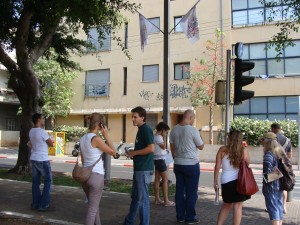The National, October 10, 2009
“Welcome to Gaza” isn’t a greeting you’d expect to hear in Israel. But a current tour is bringing the Strip to the sidewalks of Tel Aviv.
You Are Not Here is offering a free audio visit to Gaza City in Tel Aviv. Tourists start by printing the two-sided map from You Are Not Here’s website. When they hold the bird’s eye view of Gaza to the light, the streets of Tel Aviv appear from the other side.
At each of the 20 sites in Tel Aviv, visitors find a sticker on a utility pole instructing them to call the local “Gaza Tourist Hotline” from their cell phones. Their recorded guide, Laila el-Haddad, a prominent Gazan journalist, activist, and blogger, gives an insider’s look at the corresponding place in the Strip. In this manner, Israelis “visit” Mahmoud Abbas’s house, Palestinian Parliament, the Great Omari Mosque amongst other places.
But el-Haddad is quick to point out that Israelis aren’t just visiting sites. “We are inviting people to enter the consciousness of the average Gazan,” she says. “It’s not just a visit to Mahmoud Abba’s house, but his house as a symbol of corruption.”
Tel Aviv also plays an important role in the tour. “The buildings and the people become the set to your audio story,” Mushon Zer-Aviv, co-creator and a native of Tel Aviv, explains. As Israelis watch passersby on café-lined Rothschild Street, for example, they listen to el-Haddad narrate a trip to the United Nations Relief and Works Agency:
“No, we’re not at Saraya Prison, though one might think so from the barricaded and barb-wired walls…. Please hand your IDs to the security guard to obtain a visitor’s permit—security is very strict here. UNRWA was established by the UN after the 1948 conflict when nearly 800,000 Palestinians were forced from their homes and gained a tragic new title: refugee…. My husband, Yassine, is actually a refugee from birth, born in a camp in Lebanon…”
For each destination, el-Haddad offers vivid, personal impressions of Gaza. And by creating memories, of sorts, of the Strip in Tel Aviv, Zer-Aviv and el-Haddad seek to help Israelis forge a lasting connection to Gaza.
“We want to reengage, rather than disengage,” Zer-Aviv says.
As such, the two seek to depict Gaza as more than a tragic story. “Tragedy doesn’t always lead to empathy,” Zer-Aviv points out, but showing the humanity of the “other” does.
“It blurs the lines,” Zer-Aviv says.
When el-Haddad picked the sites in Gaza City for the tour, it was important to her to include places in Gaza that aren’t overtly related to the conflict, such as popular restaurants, markets, and recreational spots. Israeli tourists walk away with images of Palestinians eating, playing, and socializing, making it harder for them to consider the people of Gaza as a faceless whole.
“People have a very monolithic understanding of Gaza,” el-Haddad explains. “I wanted to challenge that.”
Zer-Aviv, who was an army medic in Gaza during his mandatory IDF service, also hopes that Israelis’ will interrogate their self-concepts, as well.
As a young soldier—donning an olive green uniform, a gun dangling from his shoulder—Zer-Aviv would stand in the back of the army ambulance as it drove around the Strip, looking out at Gaza from the open doors.
“I remember this incident,” he says, “when some kids on a donkey cart rode behind us. Being super young and naïve, I waved hello to them and I was surprised when they didn’t wave back. I couldn’t understand the divide between my own self image—a friendly 19-year-old teenager—and the image the kid was seeing—a soldier, symbol of oppression and occupation. But that’s exactly what we’re trying to address, these schizophrenic personal and political identities.”
The tour, both el-Haddad and Zer-Aviv emphasize, is not an attempt at normalization, nor are they trying to make the two coastal cities symmetrical. Rather, they hope to momentarily disorient the tourist and then reorient them with a new perspective—one that includes Gaza as part of their consciousness.
“I don’t have very lofty expectations, nor am I under any illusions about what this project can achieve,” el-Haddad says. “But if I am able to reengage a single person, to personalize the situation and create a permanent attachment to [Gaza] in their minds, then I have done something.”
Some Israelis might already be familiar with the tour, as it had a brief run on Tel Aviv streets in July 2007. It was again added to the urban landscape as part of Art TLV 2009, the city’s biennial art event which is funded, in part, by the municipality of Tel Aviv. Additional support came from an Israeli company, GreenfieldTech, which donated the phone system. However, due to a lack of funding, manpower, and time, el-Haddad’s recordings are only available in English.
Ron Ozery, a 30-year-old Israeli, wasn’t bothered by the language. He was disappointed, however, by the content. “It’s too political,” he remarks. “Israel bombed this, Israel trashed that. We have the Goldstone Report for that.”
But Shani Ronen, 29, disagrees, “Things are political today, especially after the war. To make [the tour] apolitical would be unrealistic.”
Ronen is so enthusiastic about the project that she is planning a group tour to the sites in Tel Aviv. “It gives us a chance to see a place we [Israelis] have no access to. The distance to Gaza isn’t far, but it is very far emotionally. People are disconnected. [This] brings it very close.”
